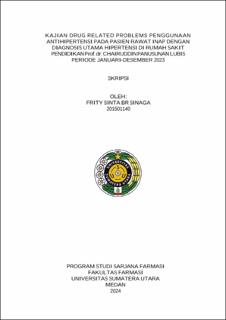| dc.description.abstract | Background: According to the World Health Organization (WHO) normal blood pressure limits are 120-140 mmHg systolic pressure and 80-90 mmHg diastolic pressure. A person is declared to have hypertension if their blood pressure is more than 140/90 mmHg. Cases of hypertension according to data from the World Health Organization (WHO) 2015 show that around 1.13 billion people in the world suffer from hypertension, which means that every 1 in 3 people in the world is diagnosed with hypertension, so reviewing Drug Related Problems to improve the effectiveness of drug therapy in hypertension.
Objective: To determine the incidence of DRPs and the magnitude of the incidence of DRPs in the use of antihypertensives in patients hospitalized at Prof. Dr. Chairuddin Panusunan Lubis Teaching Hospital in the period January-December 2023.
Methods: Research that is descriptive cross sectional with data collection is done retrospectively and the sampling technique in this study uses purposive sampling technique. This research was conducted in November 2023-February 2024 at the Prof. dr. Chairuddin Panusunan Lubis Teaching Hospital for the period January- December 2023.
Results: Of the 37 patient medical records studied, it was found that the majority of patients were female (51.38%) and the largest age group was patients aged 60 years and over (62.16%). The most common length of hospitalization was 5-8 days (54.05%), with the most common main diagnosis of Hypertensive Heart Disease (48.65%) and the most common comorbidity was hypokalemia (16.43%). The most commonly used drug dosage form was tablets (85.35%), while the most prescribed antihypertensive class was Calcium Channel Blocker (CCB) (30.18%). The most common single antihypertensive use was amlodipine (30.43%), while the most commonly used antihypertensive combination was amlodipine and kandesartan (11.1%). In addition, patients who experienced Drug Related Problems (DRPs) were found to be 8.11%, with categories of additional therapy needs (33.33%) and too high doses (66.67%).
Conclusion: There were Drug Related Problems (DRPs) in the use of antihypertensives in inpatients at Prof. Dr. Chairuddin Panusunan Lubis Teaching Hospital during the period January-December 2023, with 3 patients (8.11%) from a total of 37 medical records. From the incidence of DRPs, it was found that the most common categories of DRPs were adverse drug reactions as many as 2 cases (66.67%), and the need for additional therapy as many as 1 case (33.33%). | en_US |


